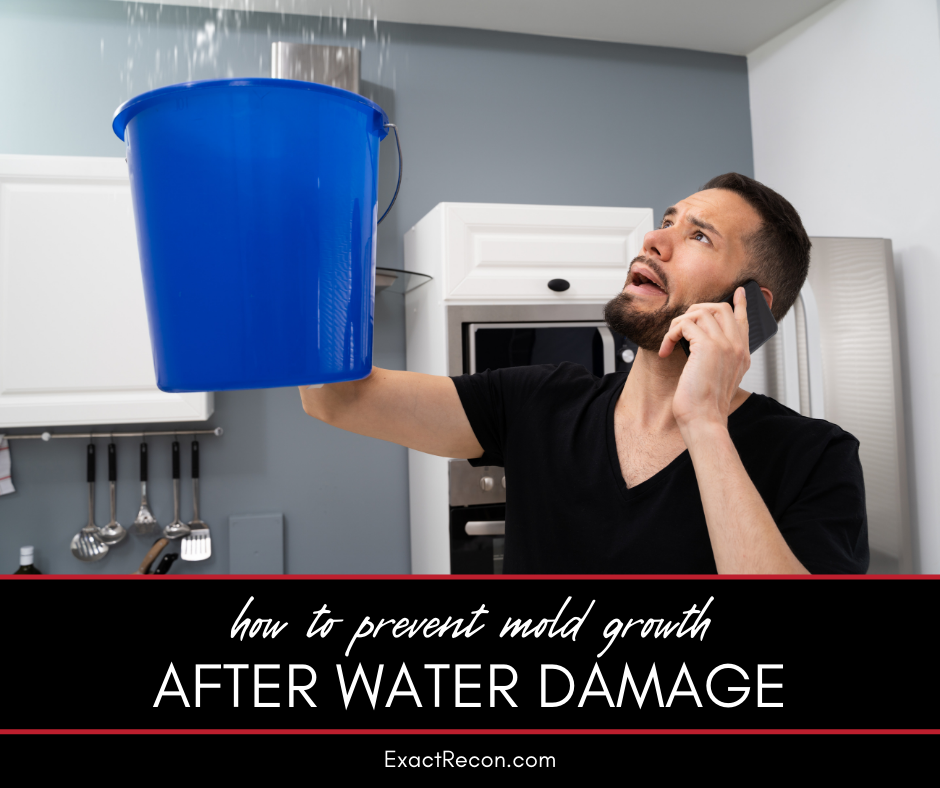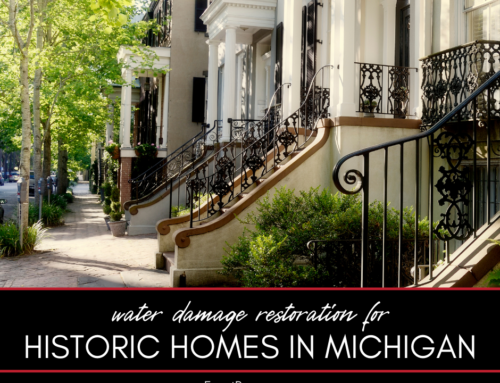Water damage can create the perfect conditions for mold growth, posing serious health risks and causing extensive damage to your home. Preventing mold growth after water damage is crucial for maintaining a safe and healthy living environment. If you experience water damage, the best way to prevent mold growth is to call a professional for water damage remediation.
How to Prevent Mold Growth After Water Damage
This guide provides detailed steps for preventing mold growth after water damage. It covers the following:
- The importance of professional water damage remediation
- Immediate steps to take after water damage
- Drying and dehumidifying the affected area
- Cleaning and disinfecting surfaces
- Monitoring for mold growth
- Long-term prevention strategies
Here’s a closer look at each.
The Importance of Professional Water Damage Remediation
Calling a professional for water damage remediation is the most effective way to prevent mold growth. Professionals have the expertise, equipment, and techniques to thoroughly dry and clean affected areas, ensuring that no moisture is left behind. They can identify hidden water damage, address potential mold issues, and restore your home to its pre-damage condition. Attempting to handle water damage yourself can result in incomplete drying and cleaning, creating ideal conditions for mold growth. Professional remediation provides peace of mind and protects your home from future issues.
Related: Expert advice on water damage, fire damage, mold and more
Immediate Steps to Take After Water Damage
After experiencing water damage, it’s crucial to act quickly to prevent mold growth. Start by stopping the source of water, whether it’s a leaking pipe, roof, or appliance. Turn off the water supply if necessary. Remove standing water using pumps, wet/dry vacuums, or buckets. Open windows and doors to improve air circulation and help with the drying process. Remove water-damaged items, such as furniture, rugs, and personal belongings, to a dry area to prevent further damage and mold growth. If possible, elevate wet items off the floor to improve airflow underneath.
Drying and Dehumidifying the Affected Area
Thoroughly drying the affected area is essential for preventing mold growth. Use fans, dehumidifiers, and air movers to speed up the drying process. Place fans strategically to direct airflow over wet surfaces and towards open windows or doors. Use dehumidifiers to reduce humidity levels in the air, creating an environment less conducive to mold growth. If the water damage is extensive or the affected area is large, consider renting industrial-grade drying equipment for more effective results. Monitor the drying process closely, and keep equipment running until all surfaces are completely dry.
Related: Sewage backup in your home
Cleaning and Disinfecting Surfaces
After drying the affected area, clean and disinfect all surfaces to remove any remaining moisture and prevent mold growth. Use a mixture of water and detergent to clean hard surfaces, such as walls, floors, and countertops. For porous materials, such as wood and drywall, use a specialized cleaner designed for mold prevention. Disinfect surfaces with a solution of bleach and water (1 cup of bleach to 1 gallon of water) to kill any mold spores that may be present. Wear protective gear, such as gloves and masks, while cleaning and disinfecting to avoid exposure to mold and cleaning chemicals.
Monitoring for Mold Growth
Even after thorough drying and cleaning, it’s important to monitor the affected area for signs of mold growth. Regularly inspect the area for visible mold, musty odors, and changes in the condition of materials, such as discoloration, staining, or warping. Pay attention to any new or worsening respiratory symptoms, which can indicate the presence of mold. If you notice any signs of mold growth, call a professional for mold remediation immediately. Early detection and prompt action are crucial for preventing extensive mold damage and protecting your health.
Long-Term Prevention Strategies
Implementing long-term prevention strategies can help minimize the risk of mold growth after water damage.
Control Humidity Levels: Use dehumidifiers and air conditioners to maintain indoor humidity levels between 30% and 50%. Monitor humidity levels with a hygrometer and ensure proper ventilation in moisture-prone areas, such as bathrooms, kitchens, and basements.
Fix Leaks Promptly: Repair leaks in plumbing, roofs, and windows as soon as they are detected. Even small leaks can create the moisture needed for mold growth.
Use Mold-Resistant Products: When building or renovating, consider using mold-resistant drywall, paint, and insulation to reduce the risk of mold growth.
Ensure Proper Ventilation: Use exhaust fans in bathrooms, kitchens, and laundry rooms to remove excess moisture. Open windows and doors when weather permits to improve air circulation.
Clean and Maintain: Regularly clean and inspect areas prone to moisture, such as showers, sinks, and basements. Use mold-killing products to clean surfaces where mold is likely to grow.
FAQ About Preventing Mold Growth After Water Damage
Check out these commonly asked questions about preventing mold growth after water damage. If you don’t see your question here, please call our office and we’ll find you the answers you need.
How Quickly Does Mold Grow After Water Damage?
Mold can begin to grow within 24 to 48 hours after water damage. Acting quickly to dry and clean the affected area is crucial for preventing mold growth.
What Are the Signs of Mold Growth?
Signs of mold growth include visible mold, musty odors, discoloration, staining, and warping of materials. Respiratory symptoms, such as coughing and sneezing, can also indicate mold presence.
Can I Prevent Mold Growth Myself After Water Damage?
While you can take immediate steps to dry and clean the affected area, calling a professional for water damage remediation is the most effective way to prevent mold growth. Professionals have the expertise and equipment to ensure thorough drying and cleaning.
Related: How does homeowners insurance work after a disaster?
How Can I Control Humidity Levels in My Home?
Use dehumidifiers and air conditioners to maintain indoor humidity levels between 30% and 50%. Ensure proper ventilation in moisture-prone areas and monitor humidity levels with a hygrometer.
Why Is Professional Water Damage Remediation Important?
Professional water damage remediation is important because professionals have the expertise, equipment, and techniques to thoroughly dry and clean affected areas. They can identify hidden water damage, prevent mold growth, and restore your home to its pre-damage condition, ensuring your safety and peace of mind.
Do You Need a Disaster Remediation Expert in Washtenaw County or Jackson County?
If your home has already been damaged, we can help. Check out our services and call Exact Recon for your free disaster remediation quote today. We offer:
- Water damage restoration
- Fire damage restoration
- Mold removal and remediation
- Fire and smoke restoration
- Sewer cleanup and disinfecting
- Reconstruction
- Wind and storm damage repair









